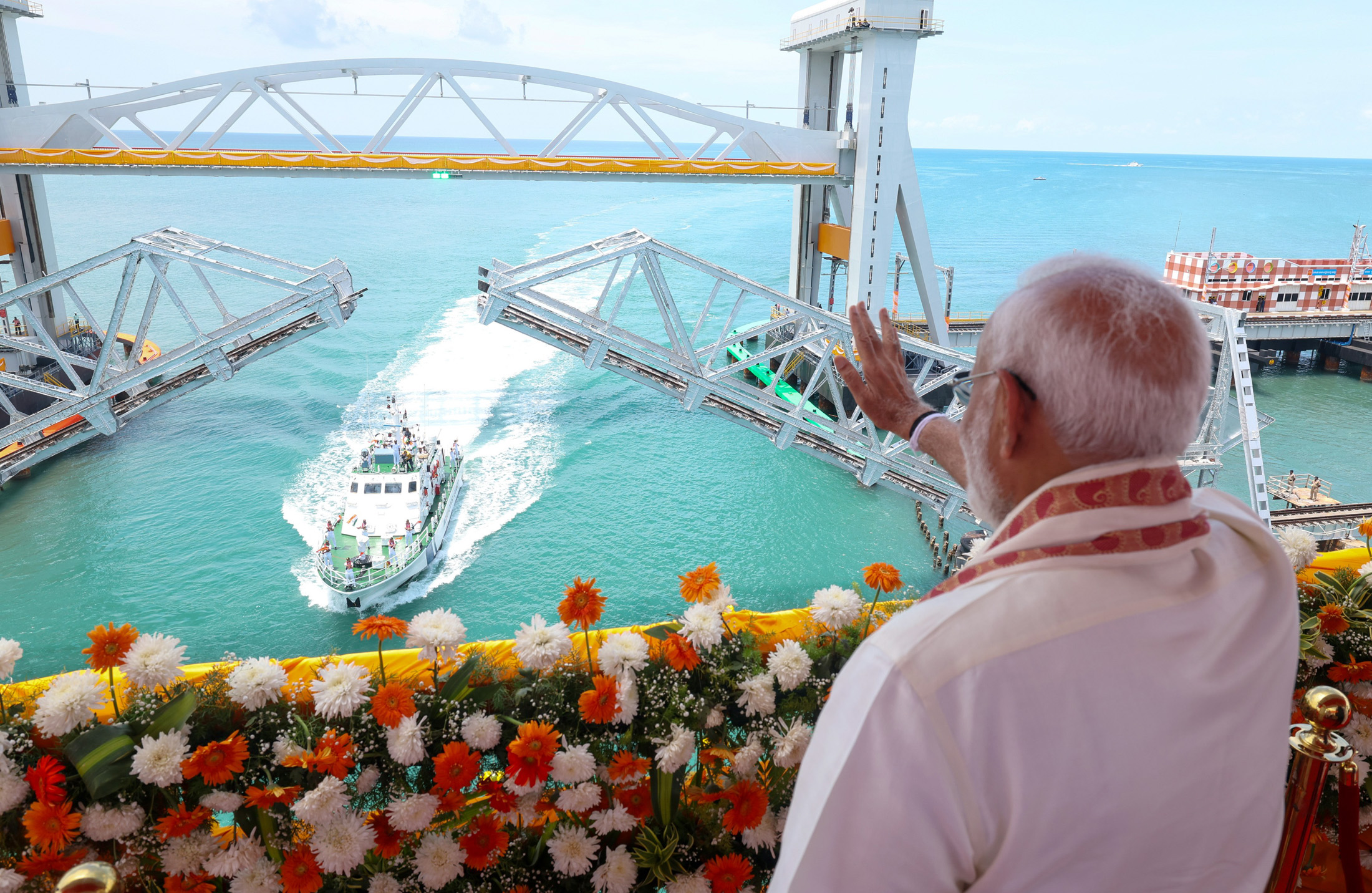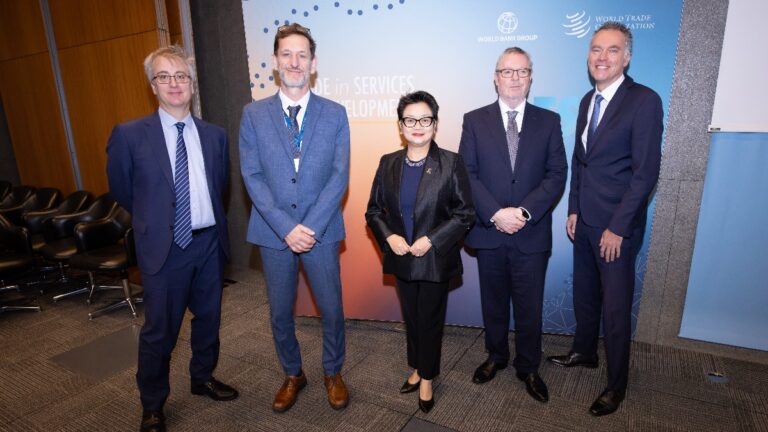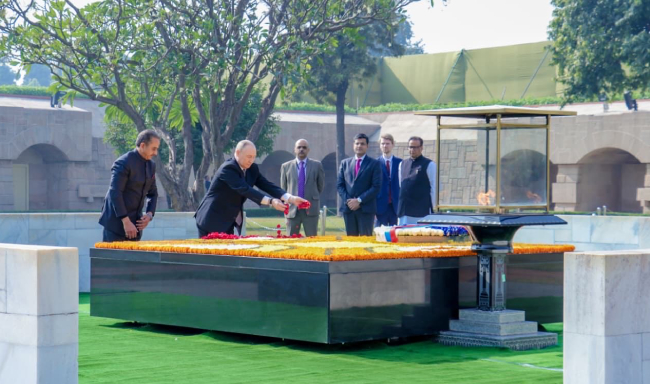
Prime Minister Narendra Modi inaugurated the Pamban Rail Bridge today and laid the groundwork for projects exceeding ₹8,300 crore in Rameswaram, Tamil Nadu. This event, coinciding with Ram Navami, signifies advancements in rail and road connectivity, particularly with the completion of the 2.08-km Pamban Bridge, India’s first vertical-lift sea bridge, constructed at a cost of ₹550 crore to connect Rameswaram to the mainland. The bridge allows big ships to sail underneath while enabling faster train travel.

While Modi’s event on April 6, 2025, showcases the successful completion of the Pamban Bridge, it also highlights the stark contrast with numerous projects that have either been delayed or not yet initiated. Since Modi took office in 2014, many initiatives have faced significant setbacks, revealing a disconnect between promises made and actual progress, often accompanied by environmental controversies.
Delays and resistance
Over 50 major projects have been launched since 2014, with only 25 completed by 2025, while 15 are delayed and 10 remain unstarted. The Rameswaram event emphasizes achievements but also sheds light on the challenges posed by land acquisition, environmental concerns, funding shortages, and community resistance.
Projects like Smart Cities, Namami Gange, Char Dham, Bullet Train, and Vadhavan Port have struggled to meet their targets, primarily due to land issues, compounded by environmental and funding challenges. Namami Gange has faced delays in securing approvals for sewage treatment plants since 2019, while Vadhavan Port is still awaiting clearance amid concerns from the local fishing community. The controversial Ken-Betwa river linking project has been stalled since 2014, awaiting ecological approvals. The Smart Cities Mission, launched in June 2015 with a goal of developing 100 cities by 2020 and a budget of ₹48,000 crore, has seen only 60 cities nearing completion of 75% of their 7,800 projects by 2025, with 5,000 operational. The original deadline has long passed, and costs have escalated by ₹10,000 crore due to slow funding and coordination issues, leaving 40 cities still lagging.
Namami Gange, launched in June 2014, set out to cleanse the Ganges by 2019 with a budget of ₹20,000 crore. As of 2025, only 200 out of 326 planned projects, including sewage treatment facilities, are expected to be completed, marking a six-year delay. The total expenditure has escalated to ₹27,000 crore, with ₹7,000 crore remaining unutilized, according to a 2024 audit, while pollution levels persist.
The Char Dham Highway Project, which commenced in December 2016, aimed to construct 900 kilometres of roads by 2020 with an investment of ₹12,000 crore. By 2025, it is anticipated that 700 kilometres will be finished, resulting in a five-year delay. The budget has increased to ₹15,000 crore due to environmental setbacks, and the project has faced legal challenges in the Supreme Court regarding deforestation and landslides. Work was halted in 2019 and only resumed in 2022, missing the original 2020 deadline.
The Mumbai-Ahmedabad Bullet Train Project, announced in 2017, aimed for completion by 2022 with a budget of ₹1.08 lakh crore. By 2025, only 35% of the 508-kilometre corridor is projected to be constructed, with a new completion target set for 2028. Costs have surged to ₹1.5 lakh crore, an increase of ₹42,000 crore, primarily due to land disputes and environmental issues. The first segment, a 50-kilometre stretch between Bilimora and Surat in Gujarat, is expected to be completed by August 2026, while the entire project is now likely to wrap up by 2028, with phased implementation anticipated to finish by 2027. Over 290 kilometres of track have already been laid. Despite plans for strong environmental safeguards, including effective ventilation and commuter safety, concerns about the project’s ecological impact remain. Delays in land acquisition, especially in Maharashtra, have hindered progress and could worsen environmental challenges. Critics contend that the ecological risks may outweigh the project’s advantages and suggest that enhancing existing rail infrastructure could be a more sustainable and cost-effective alternative. The route will traverse protected forests and mangrove areas, with an estimated 80,000 trees to be cut down, posing threats to biodiversity and water resources.
India’s largest port initiative, the Vadhavan Port, was proposed in 2020 with an ambitious goal of handling 23 million TEUs annually, backed by an investment of ₹76,200 crore. However, construction is currently on hold pending necessary approvals, with a target completion date set for 2030. This project, located in Maharashtra’s Palghar district, has faced significant opposition from local fishing communities and environmental activists. The Supreme Court has mandated an independent environmental assessment, expressing concerns that the project could have detrimental effects on the environment if not managed appropriately.
The River Linking Project, which envisions 30 water connections with a budget of ₹5.6 lakh crore, is also facing challenges. As of 2025, only the Ken-Betwa link, estimated at ₹44,605 crore, has undergone a feasibility study, while construction remains stalled due to pending approvals. The full implementation of the project could take many years. Critics have raised alarms about the government’s lack of transparency regarding hydrological data, which is crucial for assessing the project’s viability. Some experts have voiced skepticism about the feasibility of the project, particularly regarding the Ken River’s non-perennial flow and its capacity to satisfy the projected demands of the Betwa River. While siltation has always been a problem in the region, additionally, there are concerns that the project could adversely impact the Panna Tiger Reserve and its surrounding ecosystems, potentially leading to a loss of biodiversity, with the Daudhan dam projected to inundate 6,017 hectares of forest land, disrupting local habitats.
Also read:
- PM to lay foundation stone of ‘controversial’ Ken- Betwa river linking project on Atal’s 100th birth anniversary
- Cabinet approves Ken-Betwa interlinking of rivers project
Environmental clearances have consistently posed challenges that disrupt project timelines. This concern was recently highlighted by Murli Manohar Joshi, a former president of the ruling Bharatiya Janata Party and current member of its Margdarshak Mandal, who, during a conference at Hindu College in New Delhi on World Water Day, criticized the government for its lack of environmental awareness. Joshi’s insights reflect a deep understanding of the issues at hand.
However, the delays in these incomplete projects stem from more than just environmental factors. Political and bureaucratic obstacles are significant, particularly regarding the One Nation, One Election initiative, which requires consensus from states but faces opposition from regional parties. Although this proposal was approved in September 2024 to synchronize elections to save ₹10,000 crore, it remains unimplemented due to the need for constitutional amendments and state agreement, with analysts predicting a possible rollout by 2029 at the earliest. Additionally, the Smart Cities initiative has struggled with coordination between central and local authorities, missing its 2020 deadline, while the Namami Gange project has been criticized for its lack of oversight, as revealed in a 2024 audit.
Experts question feasibility
Experts are raising concerns about the feasibility of these initiatives. Urban planners argue that the goal of developing 100 Smart Cities exceeds the capabilities of municipal resources. Environmentalists point out that the Namami Gange project fails to enforce necessary industrial regulations, undermining its objectives set in 2019. Engineers have deemed the 2022 target for the Bullet Train project unrealistic due to existing land laws, while activists caution that the River Linking project poses significant risks to ecosystems, leaving it in a state of uncertainty. Resistance from activists is growing, as seen in the legal challenges faced by the Char Dham project in 2019 and ongoing protests against Vadhavan Port due to concerns over coastal damage. The River Linking initiative continues to face delays as studies are still pending.
Land acquisition slows work; Public resistance blocks progress
Land acquisition has hindered progress, with public opposition further complicating matters. The Bullet Train project has encountered disputes with farmers in Maharashtra and Gujarat, where protests from 2018 to 2020 have delayed the securing of land, although it is expected that 90% will be acquired by 2025. In Gujarat, farmer rallies highlighted concerns over land loss during this period. Similarly, the Smart Cities initiative has struggled with urban land issues, as local authorities lacked the necessary capacity, resulting in missed deadlines by 2020. The Char Dham project faced resistance from landowners in Uttarakhand, causing delays over a stretch of 200 kilometres. Additionally, the Vadhavan Port project has been stalled by concerns from fishing communities in Maharashtra regarding the potential impact on their livelihoods, with a completion target now pushed to 2025. The Char Dham initiative also faced local protests related to ecological concerns, leading to legal challenges in 2019.
Funding shortages add delays
Funding shortages have contributed to these delays, with the Smart Cities initiative experiencing a ₹10,000 crore budget overrun due to slow disbursement of central funds. States like Bihar reported financial shortfalls by 2023, while the Namami Gange project has ₹7,000 crore unspent, attributed to planning issues as noted in the 2024 audit. The Bullet Train’s budget has ballooned by ₹42,000 crore, driven by inflation and extended timelines. Public resistance varies across projects; both the Bullet Train and Vadhavan Port are facing concerns related to land and livelihoods, while Char Dham and River Linking have attracted ecological critiques from experts and activists. The Smart Cities initiative has encountered logistical challenges rather than widespread public opposition, revealing a gap between promises made and the realities of implementation.
Gap between promises and delivery
Completed projects match announcements. The Pradhan Mantri Gram Sadak Yojana (PMGSY), Swachh Bharat, Bharatmala, and today’s Pamban Bridge delivered targets. Delayed projects show shortfalls. Smart Cities promised 100 cities by 2020; 40 lag. Namami Gange targeted a clean Ganges by 2019; pollution stays. The Bullet Train set 2022; it’s 2028. Char Dham aimed for 2020; 200 km are undone. Costs rose—₹10,000 crore for Smart Cities, ₹7,000 crore for Namami Gange, ₹42,000 crore for Bullet Train,₹3,000 crore for Char Dham. Deadlines were fixed; delivery stretched them.
Moreover, projects that have yet to commence, such as Vadhavan Port, One Nation, One Election, and River Linking, further exacerbate the existing gaps. While announcements create high expectations, the reality of delivery remains pending. Factors such as land acquisition, environmental concerns, funding issues, and public resistance contribute to these delays. Whether Prime Minister Modi’s third term can effectively bridge these gaps is still uncertain and remains to be seen.





